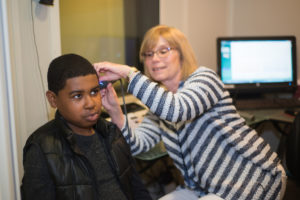Auditory Processing. What is it?
Hearing is handled by various parts of the ear. Sound waves are transformed into impulses that are received by the brain. These impulses are interpreted by the brain as speech patterns, music or other sounds. Hearing is a two-stage process – (1) reception and (2) interpretation.
 Auditory Processing is the name given to the interpretation stage, where the brain processes or interprets the auditory impulse it receives. Auditory processing is one of the basic cornerstones of learning.
Auditory Processing is the name given to the interpretation stage, where the brain processes or interprets the auditory impulse it receives. Auditory processing is one of the basic cornerstones of learning.
Hearing losses are relatively easy for an audiologist to measure, but processing deficits are not. A student with an auditory processing problem may have problems in the classroom. It is usually through observation of these problems that teacher and parents become concerned and a diagnostic battery of tests is given to the child.
Auditory processing is essential in almost all classroom learning. The child must be able to “hear,” process accurately and then remember.
Diagnosis pinpoints the areas of auditory processing where a child has a deficit, such as:
Auditory Discrimination
The ability to process the difference in two like sounds.
Auditory Memory
The ability to remember what has been said.
Auditory Figure Ground
The ability to pick out the relevant auditory signal from background noise.
Auditory Synthesis
The ability to blend sounds together to make words (a foundation skill for phonics)
Auditory Comprehension
The ability to understand story-type material.
Auditory Sequential Directions
The ability to listen, then act on a series of directions.
Letter/Sound Symbol
The ability to retrieve the correct sound when presented with a letter.
CAPD Checklist
Use this checklist to help determine if your child needs an evaluation for a Central Auditory Processing (CAP) disorder. Referrals should be based on information obtained from the child’s parents or principal caregivers, the classroom teacher, and your own observations. If a child presents with two to three, or more, of these problems, there is a possibility a CAP disorder could be present. The more problems noted means a greater likelihood of auditory problems.
- The child does not attend to instructions or does not listen to them carefully.
- He/She often misunderstands what is said.
- He/She does not comprehend verbal concepts at age/grade level.
- He/She exhibits slow/delayed response to verbal stimulation.
- He/She is easily distracted by background sound.
- He/She forgets what is said in a few seconds.
- He/She has difficulty recalling sequences.
- He/She has difficulty with phonics/speech sound discrimination.
- He/She has evident language and/or articulation problems.
What Happens During a CAP Evaluation?
Central auditory processing (CAP) is, in essence, how the nervous system manages and interprets sound. It is best described as what the brain does with what the ears hear. We all have auditory processing skills, which we use in varying amounts, according to the situation. If these skills are poorer than normal, the listener may have difficulty understanding, remembering or comprehending what is being said by someone else.
To evaluate someone’s central auditory processing abilities, a battery of listening tests is given, and the performance of the test subject is compared to that of individuals with no known central auditory problems. These tests involve having the patient listen to speech which is presented in unusual ways or in competition with noise. When the auditory system is stressed or taxed in this manner, a central auditory processing disorder may show up.
Prior to the CAP portion of the test, a standard hearing test battery including tone thresholds, speech reception thresholds, speech discrimination testing without noise, and tympanometry will be done. This must be done as close to the day of the CAP testing as is possible, because the volume levels at which the CAP tests are given are based upon individual hearing levels, and variations of five decibels are common from day to day, when human hearing is measured. Also, the effect of middle ear fluid on CAP tests is variable, and if conditions suggesting fluid are present at the time of testing, then the results are not quite as valid.
To prepare a child for central auditory processing testing, tell him or her they will be wearing headphones (demonstrate this at home if you have a pair), and will be asked to listen and repeat some words. They will also be listening for small sounds (beeps) and will need to push a button when they hear it. It is usually fun to do this. There is no pain, discomfort, wires, electrodes, or needles involved.



